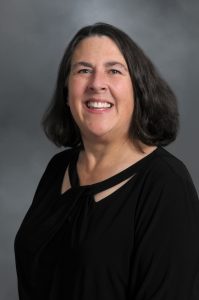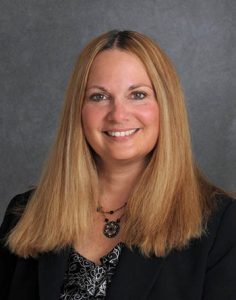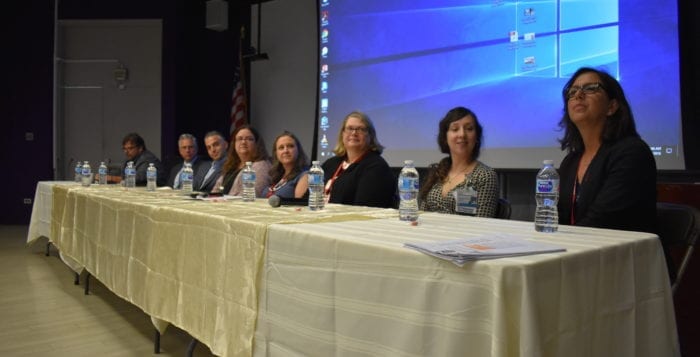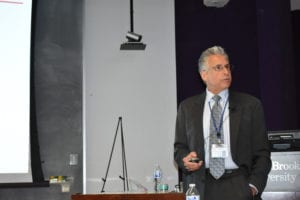For the hospital’s plethora of policies that protect the planet, the U.S. Department of Health and Human Services recently recognized Stony Brook, among others, for a commitment to decarbonize its operations and improve its resilience amid climate change.

During the recent United Nations Climate Change Conference, called COP28 in Dubai, HHS recognized Stony Brook as one of more than 130 organizations that joined the White House-HHS Health Sector climate pledge, which committed to reduce emissions by 50 percent by 2030 and have net zero emissions by 2050.
The recognition is “validating” and “wonderful” and provides the kind of excitement that “pushes you along a little further,” said Barbara Boyle, Director of Healthcare Safety at Stony Brook University Hospital.
Carol Gomes, chief executive officer and chief operating officer at Stony Brook University Hospital, added that green practices were not only good for the university, but were also supportive of the bottom line.
“When you reduce bio hazardous waste from the waste stream, it reduces expenses related to carting away” the more dangerous refuse, Gomes said. Such actions are part of the school’s fiscal responsibility.
Numerous measures
Stony Brook University Hospital has taken a wide range of steps to reduce its carbon footprint, to minimize toxins, and to reuse and recycle materials to encourage sustainability.
One of the first initiatives was to install motion and LED lighting. While the cost of a bulb might be higher initially, the lights last much longer.
“You have to think longer term, not shorter term in terms of savings,” said Gomes. “I was so proud of that project” which included retrofitting every light in the hospital, parking garage and on the roadway on the campus.

Hospital efforts include using cleaning materials that are better for the environment. In 2022, 76% of the housekeeping chemicals were green, well up from 18% in 2021.
Additionally, electricity use at the hospital declined by 13 percent from 2020 to 2022.
In the operating room, anesthesiologists use considerably less desflurane, which is damaging to the atmosphere, with an extended lifetime in the atmosphere that has 20 times the environmental impact of other gases. The use of desflurane declined by 80 percent from 2017 to 2022.
The hospital also recycled 1,635 tons of paper. Each ton of recycled paper can save 17 trees, 380 gallons of oil, 3 cubic yards of landfill space, 4,000 kilowatts of energy and 7,000 gallons of water. That means, among other benefits, the hospital saved about 28,000 trees and 11.5 million gallons of water. That is 10,000 more trees than are in all of Central Park.
Coordinating emergency care
Stony Brook has also worked on a climate resilience plan to ensure that it can remain operational in case of a major climate event, such as a hurricane, an extended heat wave, or a nor’easter, among others.
“We need to make sure the hospital can continue to remain operational,” said Boyle, which includes anticipating the needs of communities that are at a disproportionate risk of climate harm.
The hospital also has extensive plans in case Stony Brook needs to provide shelter for staff who can’t return home and return to work.
Hospital staff recently joined a discussion with community members, the Suffolk County Department of Health, emergency services such as the Red Cross, and volunteer organizations to discuss how to ensure efficient and effective communication pathways and resource allocation.
Boyle explained that she learned the specifics of Red Cross shelters and cooling centers in Municipal Buildings.
Changes in personal habits
Such professional efforts are consistent with the lessons Gomes learned from her grandmother, who herself grew up during the Great Depression. Gomes recalled how her grandmother encouraged her to turn off lights when she left a room and to shut off the faucet in the kitchen sink in between cleaning dishes.
Boyle explained that her mother-in-law Beryl Ellwood Smith, who grew up in England during World War II and had lived with Boyle’s family for the last two years, didn’t believe in throwing things out. She believed everything had a second or third use, repairing and mending items to keep them longer.
“In my family, we’ve really taken this to heart, recycling and eliminating waste,” Boyle said.
The hospital encourages staff to take similar approaches to saving and recycling in their own lives.
Staff recently received a note about ways to think about sustainable holiday decorations.
People who work in the hospital can offer their friends and family experiences rather than adding to the collection of material goods often packaged in styrofoam or plastic for holiday gifts.
The hospital is encouraging its staff to “make the connection between the workplace and the home and the importance of protecting the Earth in general,” Gomes said.







